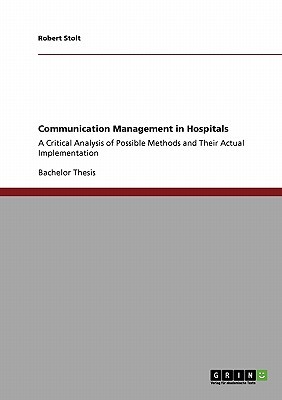
- We will send in 10–14 business days.
- Author: Robert Stolt
- Publisher: GRIN Verlag
- Year: 2009
- Pages: 68
- ISBN-10: 3640355318
- ISBN-13: 9783640355310
- Format: 14.8 x 21 x 0.4 cm, minkšti viršeliai
- Language: English
- SAVE -10% with code: EXTRA
Reviews
Description
Bachelor Thesis from the year 2009 in the subject Health - Miscellaneous, grade: 1,9, European Business School - International University Schloà Reichartshausen Oestrich-Winkel (Department for Market-Oriented Management), course: Health Care Management, language: English, abstract: In recent years, the German health care sector underwent considerable structural changes. Nevertheless, medical facilities increasingly recognise that their resources are limited and that they are subject to mechanisms of other markets, meaning that they need to ensure the own position in the health care market more than ever (Schreyögg, 2000, p. 185). Increased competition between hospitals, scarce resources, and amendments of legislation are forcing every provider of medical services to consider a sustained and efficient structure of the provision of their services over and above a strong customer orientation. With several reforms coming from the government, which were supposed to retain an eminent level of public health care and at the same time putting a halt on the consistently rising health care costs, the hospital was now heavily reliant on the number of patients treated. Thus, hospitals were faced with the challenge of retaining or gaining more patients, while concurrently having an unchanged or lower budget, which meant that the role of the hospital changed from being a mere renderer of medical services to having the function of an economic actor. Concretely, this implied for hospitals adopting a strategic concept that is aligned to the market and to the heterogeneous target groups of this market. Moreover, patients are nowadays not only driven in their demand by the quality of the medical treatment, but by a function of several different factors, which include among others the communication of a positive image through advertising and public relations. Nevertheless, business-like reasoning of the economist on the one hand and traditional Aesculapius professional perception of the
EXTRA 10 % discount with code: EXTRA
The promotion ends in 23d.16:10:37
The discount code is valid when purchasing from 10 €. Discounts do not stack.
- Author: Robert Stolt
- Publisher: GRIN Verlag
- Year: 2009
- Pages: 68
- ISBN-10: 3640355318
- ISBN-13: 9783640355310
- Format: 14.8 x 21 x 0.4 cm, minkšti viršeliai
- Language: English English
Bachelor Thesis from the year 2009 in the subject Health - Miscellaneous, grade: 1,9, European Business School - International University Schloà Reichartshausen Oestrich-Winkel (Department for Market-Oriented Management), course: Health Care Management, language: English, abstract: In recent years, the German health care sector underwent considerable structural changes. Nevertheless, medical facilities increasingly recognise that their resources are limited and that they are subject to mechanisms of other markets, meaning that they need to ensure the own position in the health care market more than ever (Schreyögg, 2000, p. 185). Increased competition between hospitals, scarce resources, and amendments of legislation are forcing every provider of medical services to consider a sustained and efficient structure of the provision of their services over and above a strong customer orientation. With several reforms coming from the government, which were supposed to retain an eminent level of public health care and at the same time putting a halt on the consistently rising health care costs, the hospital was now heavily reliant on the number of patients treated. Thus, hospitals were faced with the challenge of retaining or gaining more patients, while concurrently having an unchanged or lower budget, which meant that the role of the hospital changed from being a mere renderer of medical services to having the function of an economic actor. Concretely, this implied for hospitals adopting a strategic concept that is aligned to the market and to the heterogeneous target groups of this market. Moreover, patients are nowadays not only driven in their demand by the quality of the medical treatment, but by a function of several different factors, which include among others the communication of a positive image through advertising and public relations. Nevertheless, business-like reasoning of the economist on the one hand and traditional Aesculapius professional perception of the


Reviews